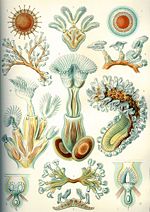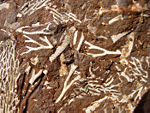- Kingdom: Animalia
- Phylum: Bryozoa
| Bryozoan |
|---|
| Scientific Classification |
|
| Classes |
| Bryozoan colony |
Bryozoans are marine invertebrates belonging to the taxonomic phylum Bryozoa also called the "moss animals." [2] They are called moss animals because when they form a colony, they often resemble moss. They can either live in large colonies and sometimes by themselves. Today there are about 5,000 identified species of Bryozoa. They are all aquatic and mostly sessile. They usually live in shallow waters but have also been found in waters 6,000 meters deep.[3] You can find them on rocks, seaweed, or even on the bottom of ships. Coral and Bryozoans are often confused with each other, however bryozoans are much more complex. [4]

Bryozoans live in colonies, are aquatic, and have bilateral symmetry. [5] Individually, they are about a millimeter long and have a single opening where the lophophore sticks out into the water. [6] The outer layer of the zooid's body is called the exocyst, which is made up of either a gelatinous substance or chitin. They lack respiratory, circulatory, and excretory systems. They exchange oxygen and carbon dioxide with the environment through diffusion. Their nervous system consists of small ganglia between the anus and the mouth.[7]
Each bryozoan contains a lophophore which holds many ciliated tentacles that reach into the water to trap food by creating a water current directed towards its mouth. It can be retracted very quickly by its retractor muscle and the opening is covered by the operculum. [8] On the front side of the zooid (a singular organism of the colony) is a place where the lophophore can be pulled back into the body using it's muscles. Inside the lophophore is the mouth, and outside the lophophore is the esophagus, stomach, gut, and anus. It is because of this that a Greek name for the Bryozoans is Ectoprocta, meaning "anus outside." [9] A tendon called the funiculus joins the bottom of the body wall to the stomach. The inside of the body is a cavity filled with water which gives the lophophore space to be drawn into. [10]
A Bryozoan colony is made up of mulitple zooids connected to each other by thin strands of tissue. [11] The main tube that holds the whole colony together branches out to make room for more zooids. [12] Sometimes, different varieties and species of Bryozoans are found in the same colony and all have different jobs. Some are autozooids, which are used for feeding, and others are heterozooids, which rely on the autozooids for food and nutrients. Even though they live in a colony, they still behave as though they are an individual animal. [13]
There are many different types of heterozooids in the colony that all have different jobs. A few types are Vibracula, which use their long bristles to clean off the colonies surface, Avicularia which form a point that quickly closes together to discourage any nearby animals from eating it, and kenozooids, which are used to fill up any empty spaces or holes and strengthen the colony. [14]
Bryozoans can reproduce a few different ways. Any piece of the colony that breaks or falls off, can regenerate to start a new colony. Also if it dies during the winter seasons, which it often does, then they usually regrow themselves when summer comes. They can reproduce asexually by budding. Budding is when cells on an organism enlarge and separate from the parent. They then swim freely until they find a hard surface to plant themselves on then they start a new colony. They are called the parent zooid. Another species of bryozoans reproduce asexually by forming statocysts. These are cells, surrounded by a protective layer that is able to withstand unfavorable conditions. When it is once again safe, they form a new zooid. [15]
The majority of bryozoans contain both ovaries and testes, meaning that they are hermaphroditic. However, most species use their tentacles to grab floating sperm from the water and fertilize their eggs that are being held in special chambers called ovicells. The fertilized eggs form into free-living larvae which escape from the ovicells and float in the water until they come upon a new place to live. They then form into zooids and become the parent zooid of a new colony of bryozoans. [16]

All bryozoans are aquatic. Most are marine, but a few are freshwater. Bryozoans make their homes on any kind of hard substance such as rocks or grains of sand, which makes them easily become fossils over time. Basically all species are sessile, although there are a few colonies that are able to move around slowly. There is also one very unique bryozoan which swims freely around the Antarctic Ocean. [17]
Bryozoan's diet is made up of small organisms such as diatoms or other types of algae. It is a filter feeder, which means that their ciliated tentacles create a current aimed towards its mouth, and it filters out the tiny organisms. By filter feeding, they keep the water clean because they are filtering out any extra food debris and eating it. [18] They are basically indifferent to polluted waters. They have even been found in sewage pipes. [19]
Freshwater bryozoa come from Class Phylactolaemata in Phylum Ectoprocta. This Class contains 5 families which are Cristatellidae, Fredericellidae, Lophopodidae, Pectinatellidae, and Plumatellidae. [20]
Freshwater Bryozoans are very similar to saltwater bryozoans in how they look, act, and reproduce; except, of course, for the fact that they are found in freshwaters, like lakes or streams, generally attaching themselves to solid surfaces ranging from plants to pieces of plastic. Two types of habitats they live in are lentics (calm waters like ponds) and lotic (flowing water). [21] They prefer to live in temperatures of 41-86 degrees F, which is usually in the shallower waters.[22]
Freshwater Bryozoans are also filter feeders, eating a variety of organisms, but mainly plankton and detritus (decayed matter). [23]
In relation to humans they can be both a good and bad thing. They help to carry around certain nutrients and give food to various types of organisms. However they also can be irritating in that they grow on all sorts of pipes which can cause drainage and irrigation issues.[24]
|
||||||||||||||||||||